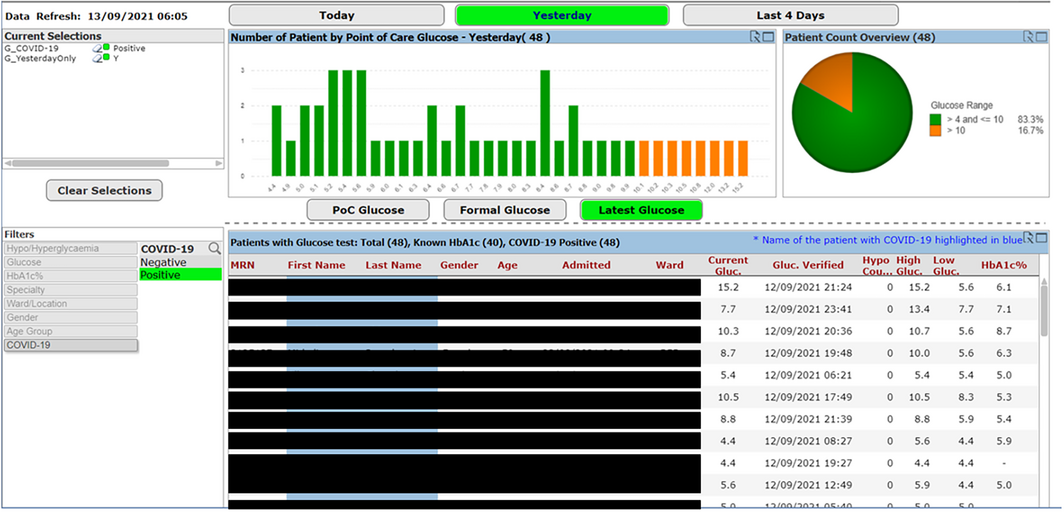To the Editor: The coronavirus disease 2019 (COVID‐19) pandemic has strained health systems in New South Wales, and hospitals have rapidly adapted to care for inpatients with COVID‐19. In the 4 weeks leading up to 9 September 2021, 9330 locally acquired cases were diagnosed in Western Sydney alone.1
The management of large numbers of COVID‐19 inpatients with diabetes has been challenging. People with diabetes are a vulnerable population who are at risk of adverse outcomes from COVID‐19, with a two‐ to threefold likelihood of death compared with people without diabetes.2 Hyperglycaemia is associated with higher risk;3 hence, good glucose management is desirable. Exacerbation of diabetes by dexamethasone therapy, used to treat patients with COVID‐19, and the development of steroid‐induced hyperglycaemia in non‐diabetic patients present further challenges.
Traditional models of care relying on referrals from parent teams to an endocrinologist (or registrar), who then reviews the patient daily to chart insulin, are inefficient and impractical for this situation. We have developed a virtual inpatient diabetes management service (vIDMS) as a means for a small diabetes team to manage COVID‐19 inpatients with diabetes. The success of this model has revolved around an electronic medical record, electronic inpatient prescribing, a diabetes dashboard, and videoconferencing communications.
The recording of all glucose measurements (including point of care) within the electronic medical record has enabled the systematic capture and display of hospital‐wide glucose data on a diabetes dashboard (Box). This also allows viewing and filtering by any variable in the electronic medical record, such as ward, age, biochemistry (including formal laboratory glucose and glycated haemoglobin), development of hypoglycaemia, prescribed medications (including corticosteroids), and COVID‐19 status. Therefore, COVID‐19 patients with diabetes or hyperglycaemia are easily identified.
The vIDMS, comprising of a consultant, a registrar and a diabetes educator, reviewed patients with COVID‐19 and hyperglycaemia on a daily basis, using the dashboard and electronic medical record, by sharing a screen on a videoconferencing platform. Remote management was undertaken through the electronic medical record, including medication and insulin dose adjustments. Communication with ward staff and patients with COVID‐19 through the electronic medical record, or by telephone or video, was undertaken when needed, including for diabetes education. Entry into the COVID‐19 wards and usage of personal protective equipment was not required. In the 6 weeks to 5 September 2021, 112 COVID‐19 patients with diabetes were thus managed in Westmead Hospital (median age, 62 years; range, 23–91 years), with up to 40 patients reviewed per day.
Necessitated by COVID‐19, the future of inpatient diabetes management is now here. With one‐quarter of patients in metropolitan hospitals having self‐reported diabetes4 but insufficient specialised diabetes staff to provide individual management, the vIDMS will become a significant part of the wider model of diabetes care for large hospitals.5 While initial and intermittent face‐to‐face contact remains valuable to build a relationship and discuss relevant issues, and careful review of medical records is necessary to understand perturbations in glucose levels (eg, fasting, missed medication), the vIDMS enables daily specialist care for large numbers of patients with diabetes by a small team. The health system needs to facilitate its wider application for the management of both COVID‐19 and non‐COVID‐19 patients with diabetes in hospital.
Box – Diabetes dashboard showing hospital‐wide glucose data for patients with coronavirus disease 2019 (COVID‐19)

- 1. NSW Health. Locally acquired COVID‐19 cases and tests in the last 4 weeks. https://www.health.nsw.gov.au/Infectious/covid‐19/Pages/stats‐local.aspx (viewed Sept 2021).
- 2. Apicella M, Campopiano MC, Mantuano M, et al. COVID‐19 in people with diabetes: understanding the reasons for worse outcomes. Lancet Diabetes Endocrinol 2020; 8: 782–792.
- 3. Klonoff DC, Messler JC, Umpierrez GE, et al. Association between achieving inpatient glycaemic control and clinical outcomes in hospitalized patients with COVID‐19: a multicentre, retrospective hospital‐based analysis. Diabetes Care 2021; 44: 578–585.
- 4. Bach LA, Ekinci EI, Engler D, et al. The high burden of inpatient diabetes mellitus: the Melbourne Public Hospitals Diabetes Inpatient Audit. Med J Aust 2014; 210: 334–338. https://www.mja.com.au/journal/2014/201/6/high‐burden‐inpatient‐diabetes‐mellitus‐melbourne‐public‐hospitals‐diabetes#:~:text=Conclusion%3A%20The%20high%20burden%20of,preventing%20or%20delaying%20future%20complications
- 5. Rushakoff RJ, Sullivan MM, MacMaster HW, et al. Association between a virtual glucose management service and glycemic control in hospitalized adult patients: an observational study. Ann Intern Med 2017; 166: 621–627.





We thank Associate Professor David Chipps for his contribution to the virtual Inpatient Diabetes Management Service and review of the manuscript.
No relevant disclosures.